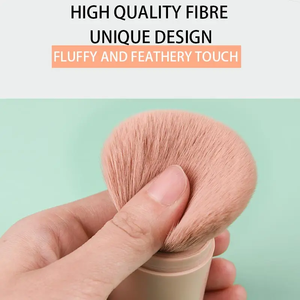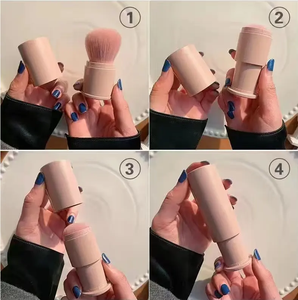(5237 products available)
















































 Ready to Ship
Ready to Ship








































































































































 Ready to Ship
Ready to Ship



































A cheek brush is a makeup tool for applying blush, highlighter, and bronzer to the cheeks. It has soft, dense bristles designed to pick up and distribute powder or cream products smoothly and evenly onto the skin. There are different types of cheek brushes depending on the specific application:
Angled Blush Brush
The angled shape of this brush allows it to apply blush precisely to the apples of the cheeks and along the cheekbones. Its dense bristles pick up a good amount of product and blend it out for a natural flush of color. It is particularly useful for contouring as well, as the angle can hug the hollows of the cheeks to deposit bronzer smoothly.
Fan Brush
Fan brushes are flat and spread-out bristles shaped like a fan. Their light and airy construction makes them perfect for dusting highlighter on the high points of the face—above the cheekbones, down the nose, and on the forehead—resulting in a subtle, lit-from-within glow. The shape allows for sheer, buildable application and minimal product waste.
Round Blush Brush
Round blush brushes have a rounded top and are dense like the angled brush. However, they lack the specific angling and instead have bristles all around the brush head. This allows the round blush brush to apply blush, bronzer, or highlighter over larger areas and achieve a more diffused effect. It can cover more surface area than the angled version.
Dome Blush Brush
Dome blush brushes are similar to round brushes, but their dome shape enables them to reach targeted areas like the apples of the cheeks specifically. The density of the bristles also provides the capability of contouring to create depth in the hollows of the cheeks. Its shape makes it ideal for precise or blended applications of blush color.
Cutoff Blush Brush
Cutoff blush brushes have a flat, cut-off edge that is perfect for applying blush in straight lines or specific patterns. This makes it great for sculpting and contouring the face, as the flat edge can define areas like the cheekbones, jawline, and nose with precision. It applies blush smoothly in a stripe for a flawless look.
Hair type
The kind of hair a brush has will determine how much product it holds and how well it applies it to the skin. Finer hair, like that on a fox brush, holds less product and gives a lighter application. This can be good for creating very subtle looks. Other types of hair, like goat or squirrel, hold more product and apply it more heavily. Brushes with squirrel hair are very soft and good for gentle applications where a light look is desired. Goat hair brushes are also soft but can apply more color. Understanding the varying characteristics of different animal hairs helps one choose a brush based on how one wants the product applied. For example, a squirrel hair brush may be best if one wants only a very small amount of blush on one's cheeks. One may prefer a goat hair brush if one's skin benefits from more color.
Brush shape
The shape of a brush affects how it places blush on the skin. Angled brushes have bristles that are slanted. This allows them to sweep blush precisely onto the apples of one's cheeks for a natural look. Flat brushes have horizontal bristles. They pack color onto high points of the face, like the cheekbones, creating a dramatic effect. Round brushes have circular heads. They deposit blush evenly over large areas, perfect for a soft all-over flush. Understanding brush shapes helps one choose one that will apply products the way one's makeup artist intends. For example, an angled brush is ideal for contouring as it fits into creases to shape the face. Knowing the purpose of different shapes means one can select one that will help achieve the desired look.
Brushing fibers
The type of fibers a brush has impacts its performance and feel. Natural animal hair brushes, like those made with squirrel or goat hair, provide a soft, luxurious experience. Their gentle application makes them ideal for subtle looks. Synthetic brushes contain nylon or plastic fibers. They offer a firmer feel compared to animal hair. This makes them suitable for creating bold makeup looks that require more pressure when brushing. Another fiber option is Taklon, made from nylon but designed to mimic the softness of natural hairs like squirrel. Taklon brushes combine the best of both worlds - the softness of animal hair and the sturdiness of synthetics. This makes them versatile for use by makeup artists who need a brush that works well for both subtle and dramatic styles. Considering the fiber types helps one select a brush that suits one's preferred application technique.
Applying the right amount of blush is essential to make it look natural and fresh. Here is a step-by-step guide on how to use a cheek brush:
Preparation
Before applying blush, ensure the skin is clean and moisturized. Use a foundation or BB cream to even out the skin tone. Apply concealer to cover any blemishes or dark circles. This creates a smooth canvas for the blush.
Pick up the product
Swirl the cheek brush onto the blush powder or press it onto the cream blush. Tap off any excess product to prevent over-application. Start with a little product, as it's easier to build up than to remove excess blush.
Application
Smile to make the apples of the cheeks more prominent. Gently sweep the brush in circular motions on the blush, gradually moving it towards the temples. Blend it well to avoid harsh lines.
Layering
If the color is not intense, repeat the process of picking up excess product and applying it until the desired intensity is achieved. It givesनोँ an even distribution of color.
Blending
Blend the blush for a natural look. Use the brush in circular motions to blend the product with the foundation or BB cream. Ensure there are no harsh lines and the blush looks seamless.
Final touches
Check the blush in natural light to ensure it looks even and natural. If needed, use a powder brush to set the blush with translucent powder for a long-lasting finish.
It is essential to prioritize safety when using a cheek brush. Here are some key considerations:
Hygiene
Keep the cheek brush clean to prevent the buildup of bacteria that can cause skin infections. Wash the brush regularly with mild soap and water, then dry it well. Use a brush cleanser for makeup artists and professionals who use various cosmetics.
Material Safety
Choose cheek brushes made from safe materials for the skin. Look for brushes with synthetic bristles or high-quality natural hair, such as squirrel or goat. Ensure the handle and ferrule are made from non-toxic materials.
Allergy Testing
Some people may be allergic to specific brush materials, mainly if they contain animal hair. Conduct a patch test before using a new brush by rubbing it on a small skin area. Check for redness, itching, or any other signs of an allergic reaction.
Proper Technique
Use the correct technique when applying blush with a cheek brush to prevent injury. Avoid applying too much pressure, as it can irritate the skin. Gentle sweeping or circular motions are enough to blend the product evenly.
Cheek brushes are makeup tools that apply powdered makeup products, such as blush, bronzer, and highlighters, to the cheeks. They come in different shapes and sizes to suit various makeup needs. The following are some of the functions, features, and designs that can be found in cheek brushes:
Q1. What is the difference between a blush brush and a regular brush?
A1. The difference between a blush brush and a regular brush is its design. The blush brush is specifically made to apply cream and powder blushes to the skin. Its bristles are super soft and angled to help in the precise application of the blush color to the cheeks. Regular brushes have firmer bristles that can apply different makeup products, including foundation and contour.
Q2. How does one choose a blush brush?
A2. To choose a blush brush, one must consider the size of the brush and the type of bristles. The size of the brush should be chosen based on the area of the cheeks where it will be applied. A small brush will only work on targeted areas, while a larger one will cover the whole cheek area. The type of bristles will depend on the makeup product being applied to the cheeks. Soft and silky brush bristles are best for powder blushes, while dense and firm ones are for cream blushes.
Q3. How does one clean a blush brush?
A3. Cleaning a blush brush is easy. Start by wetting the brush's bristles with lukewarm water. Then, apply a small amount of mild soap to the bristles and lather gently with circular motions. Rinse the bristles under lukewarm running water until the water is clear. Squeeze excess water with the fingers and lay the brush flat on a clean towel to dry completely.